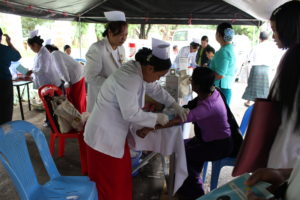As we welcome another World Hepatitis Day, the global response to eliminate viral hepatitis as a public threat is accelerating. Viral hepatitis, consisting of hepatitis B (HBV) and hepatitis C (HCV), affects more than 320 million people worldwide, with 90 percent of infections concentrated in low- and middle-income countries. The disease leads to significant liver damage and other complications over time, culminating in high rates of liver cancer and liver failure.
More than 70 million people are chronically infected with HCV. While no vaccines exist to prevent HCV, it is curable in more than 95 percent of patients with the use of directly-acting antivirals (DAAs). Since the launch of second-generation direct acting antivirals and the inception of CHAI’s Viral Hepatitis program, over 74,000 people living with HCV have been initiated on treatment across CHAI program countries and the cost per cure has fallen as low as $72 in some settings.
Despite this safe and effective treatment, less than 5 percent of those infected with HCV have been cured and affordable and equitable access to these life-saving drugs varies across the globe. A range of barriers hinders access to treatment, from a lack of supportive health infrastructure and human resources to limited domestic budgets and donor funding. Securing significant investment in public hepatitis programs and addressing these challenges will be critical to reducing mortality and incidence rates of the disease and achieving a hepatitis-free future.
While there is no “one-size-fits-all” approach to improving access, CHAI-supported HCV programs are implementing models of care that have begun to break through these barriers. In Myanmar, a public private partnership (PPP) model is demonstrating how an innovative financing mechanism, promoting collective action and multi-stakeholder engagement, can help scale affordable access to treatment.
Public-Private Partnership Model in Myanmar
Myanmar launched its first-ever public sector HCV program supported by CHAI in 2017, expanding access to testing and treatment services across 10 public sector facilities across 5 states. Within the first year, over 2,000 patients suffering from chronic HCV were initiated on treatment, using government procured commodities and a donation of daclatasvir (a direct-acting antiviral drug) from Bristol-Myers Squibb (BMS) through Americares. Due to limited availability of government-procured and donated commodities, only a small cohort of eligible patients, who are the sickest and most vulnerable, are able to access treatment free of charge through this program.
With an estimated 1.4 million people chronically infected with HCV, rapid scale up of affordable treatment to patients beyond those eligible for treatment through the public sector program will be necessary to tackle this disease. The National Hepatitis Control Program (NHCP) and CHAI, recognizing this challenge, expanded treatment through the initiation of the PPP model. Through the initiative, patients diagnosed in the public sector, who are not eligible for free care through the public program and who are willing and able to pay for a portion of treatment out of pocket, have access to high quality DAAs and lab services at reduced costs.

A screening program being conducted by the NHCP.
“By reducing the out-of-pocket costs of diagnostics and treatment, this PPP model enables more people to be initiated on treatment and complements the NHCP’s efforts to target public sector resources to vulnerable patients most in need of care”, said Dr. Win Naing, Professor and Head of the Department of Hepatology, Yangon Specialist Hospital.
Patients identified through counseling in participating public hospitals are referred to private facilities, where they access diagnosis and treatment at 40 percent of the price they would have to pay without the PPP initiative. This model has led to the initiation of 1,300 patients on treatment in just three months, demonstrating the impact that engaging multiple stakeholders can have on scaling up treatment. Without this initiative, these patients would not be able to afford the full cost of treatment and would likely drop out of care.
The Ministry of Health and CHAI are currently exploring options to build upon and expand this PPP model to complement the public sector treatment program, with an eye towards ensuring scale-up of DAA treatment across the country.
Looking Forward
Implementation experiences from countries like Myanmar are demonstrating that the barriers slowing the scale-up of hepatitis programs are surmountable. Building on these experiences, CHAI has developed a strategy to eliminate HCV, curing over 16 million people in 34 countries over the next ten years. CHAI is actively seeking partnerships to support country-led efforts to eliminate HCV as part of a global elimination campaign.
Lessons drawn from HCV access models must eventually be applied to addressing the similar but, arguably more challenging, barriers to hepatitis B prevention and care services. Without innovation in HBV service delivery, 95 percent of patients eligible for treatment will continue to suffer poor health outcomes and vaccination efforts will fall short of giving birth to the world’s first HBV-free generation.





